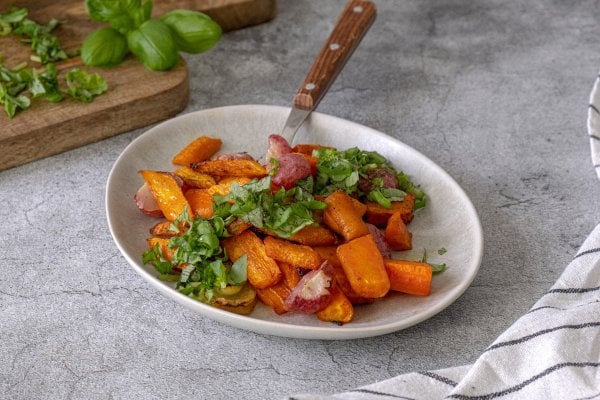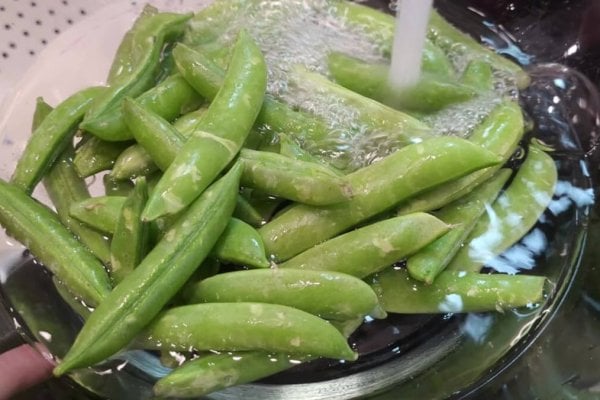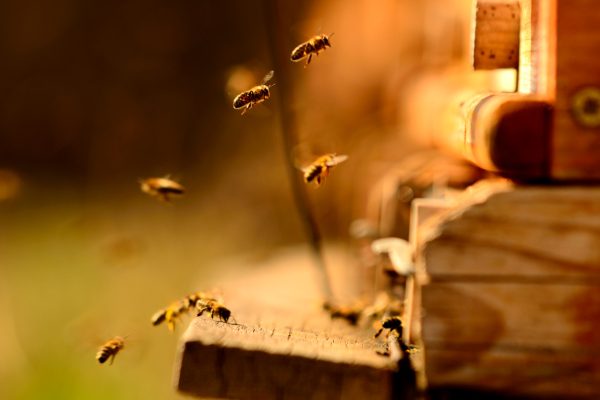It’s been a while since we’ve been here for our Pantry Chat, especially the Q&A sessions. Carolyn is two months postpartum, and little Nathaniel is a champ of a baby.
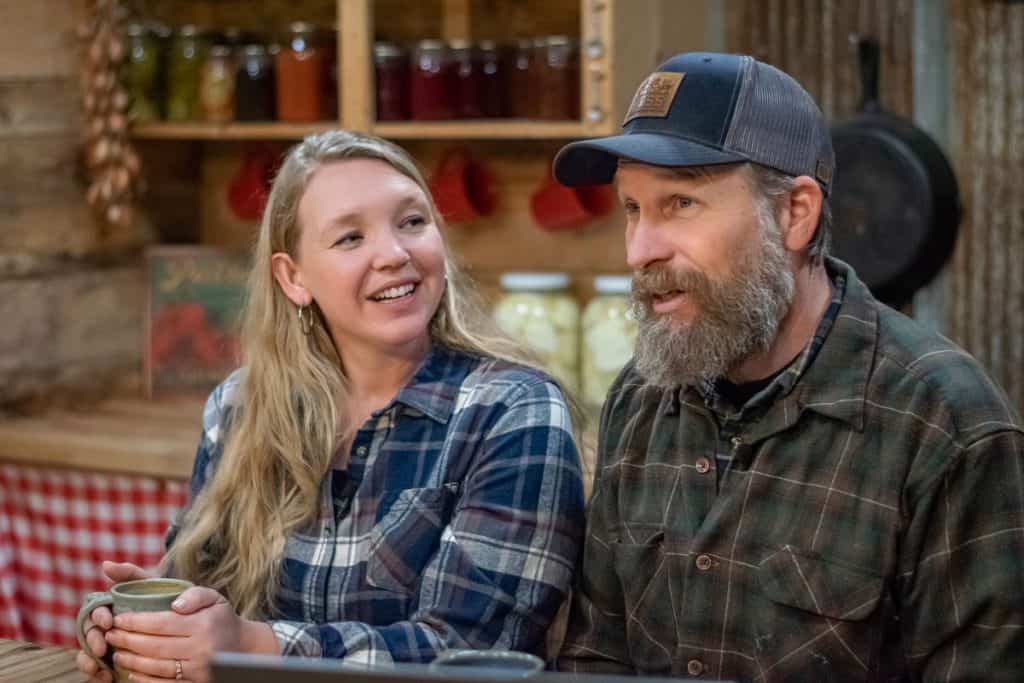
Come join us as we sit in the sunny pasture and get back into the groove of the Pantry Chat podcast.
In This Episode:
- How Carolyn is doing now that the baby is two months old.
- The first little of Kune Kune pigs on the farm.
- The weather went from winter to summer!
- Our daughter’s introduction to raising dairy goats. Learn more about raising dairy goats here.
- Check out the book Independent Farmstead by Beth Dougherty.
- How we got crops in the ground when we still had snow in the main garden (hint: using permaculture practices!). Learn more about garden season extenders here.
- Adding arnica to a comfrey salve – be sure you don’t use this on open wounds! Learn how to make a bone-healing comfrey compress here. Learn how to make arnica oil here and homemade arnica salve here.
- The advantages of canning over freezing. Learn more about canning here.
- What kind of salt to use for fermenting (spoiler alert, we use Redmond Real Salt. That link will get you 15% off your order!).
- What we do with our hoop house during the winter.
- Grab your Homestead Kitchen magazine now! This month is all about Peas.
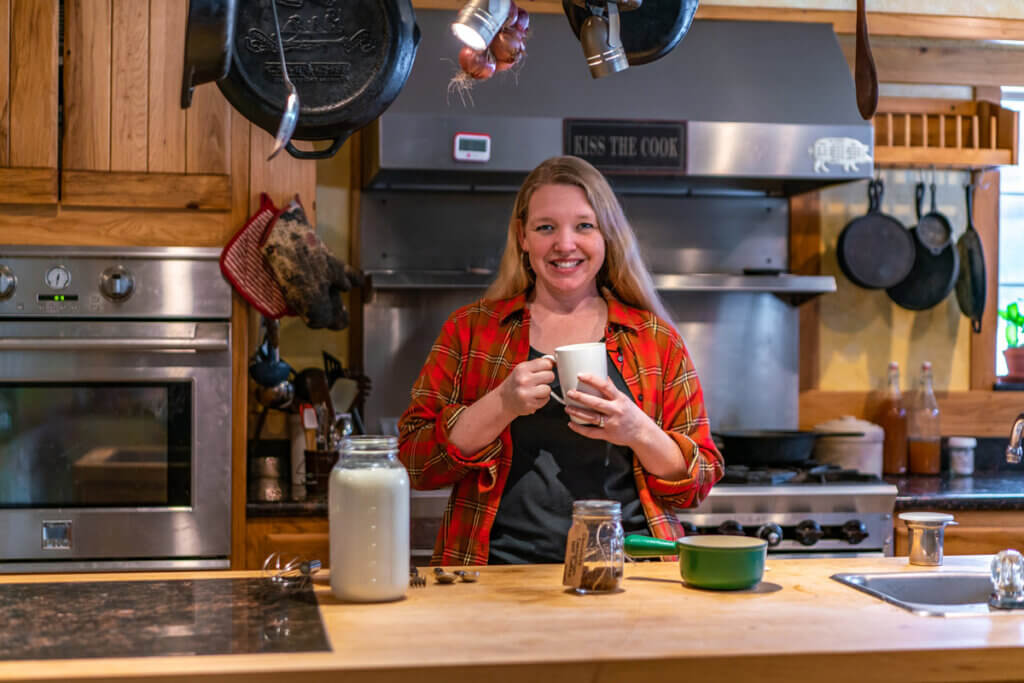
More Posts You May Enjoy
- Laundry Strategies (How to Keep Up)
- Affordable Clothing for the Homestead
- My Secret to Running a Productive Household
- Meal Planning on the Homestead (Eating Seasonally)
- How to Beat Inflation at the Grocery Store
- Building Up a Well-Stocked Pantry
- Prepping Your Pantry for Preserving Season
- How to Get 3 Home Cooked Meals on the Table Every Day
- My Preserving Year-at-a-Glance
- Tips for Homesteading With Children
- Learn to Homestead While on a Budget
- Homesteading While Pregnant
- Storing a Year’s Worth of Food (Pantry Tour)
- 7 Pantry Staples to Always Have on Hand
- Teaching Our Children To Have a Productive Morning
Josh: Hey you guys. This is Josh
Carolyn: ... and Carolyn
Josh: ... with Homesteading family, and welcome to this week's episode of the Pantry Chat: Food for Thoughts.
Carolyn: The sun's coming out here in the front pasture and you can see it's getting bright, but today we are back. We've been away for a while with new baby arriving and getting settled into life with new baby.
Josh: Yeah, this is the first episode for you and I in a couple of months.
Carolyn: Couple of months.
Josh: It's great to be back here hanging out with you.
Carolyn: Yeah, absolutely. It's good to be hanging out with you too. We feel a little out of practice maybe, and there's a lot going on. I don't know how much you guys can hear in the background. We're out in the front field. The river is right over there and it is rushing right now. It's that time of year where the river is just completely full. Then we've got a son who's doing something with a saw in the background.
Josh: He's making some pig boards.
Carolyn: Making pig boards.
Josh: Pig boards or little panels that you hold when you're moving pigs to help direct them and make sure that you don't get a tusk in the leg or anything like that.
Carolyn: That's a good idea.
Josh: That's not usually a risk, but our boar's got some big old tusks.
Carolyn: He's a nice guy.
Josh: He's very nice guy.
Carolyn: He's very nice, but you don't want a boar to get annoyed with you when you're moving him around.
Josh: Yeah, yeah. It is spring out here and not only are we first time back together doing the show, it's the first time we're outside filming I think.
Carolyn: I know, for the year.
Josh: The spring. Yeah.
Carolyn: It feels really nice.
Josh: Yeah, it's so nice to be out here, even though it is a little bright.
Carolyn: It is a little bright, so if I'm squinting and going like this. Hopefully you can see me. I can't see you.
Josh: We're kind of finding our groove. We've had a lot of transition obviously with a new baby in the house, and I'm sure we'll talk about that a little bit and how Carolyn's been doing and just going to catch up today. Carolyn and I'll get back in the rhythm here.
Carolyn: Yeah, we've got some of your questions you've been asking on videos that we're going to answer also.
Josh: Well I think the biggest thing right now really is just how are you doing? How are you feeling where what Nathaniel is almost two months.
Carolyn: Just two months. Yesterday he was two months old.
Josh: Oh yeah, that's right. Yeah.
Carolyn: The time just flies. It goes really fast. I am doing really well. I've had a great recovery. We ended up having a really good home birth. Everything went very smoothly and actually quite fast. I called the midwives and they arrived at our house at 11:00 PM on the day that I had Nathaniel. When they arrived I had the thought of, oh, I called them too soon. They're going to end up having to sleep on the couch. I shouldn't have called them too soon. Then he was born within about an hour and a half, an hour and 25 minutes.
Josh: I was going to say technically it was the day before he arrived, right? Yes.
Carolyn: Yeah. Yeah. He was born I think right before one o'clock in the morning.
Josh: Yeah. Yeah. It was pretty quick.
Carolyn: It came on, went really fast.
Josh: You're speedy, just the time's here, let's get it done and move on to the next thing.
Carolyn: He's baby number 10.
Josh: Yeah. Here you are a professional.
Carolyn: I don't know if that's a profession that I want, I got to say, but everything went really well and I did something different in this recovery than what I've done in past ones. I actually followed some of the, there's a name for it and I wish I could pronounce this correctly, so I'm not even going to try, but the postpartum lying in period the way that the Chinese culture does it.
Josh: Interesting.
Carolyn: A little bit. You're supposed to go a full 40 days. I just couldn't do it. But I did eat very specific meals for about the first 20 days and I think it really helped my recovery. I ate a lot of bone broth, a lot of liver, just a lot of really, really nutrient dense things. I wasn't supposed to have anything cold, only hot or warm or room temperature. Those are the geese, if you're hearing those in the background.
Josh: There are our native geese, or our homestead geese talking to the migrating Canada geese.
Carolyn: That are coming through here. Anyways, I think that really, really helped with my recovery. Another thing that I thought was really interesting is it's very normal after having a baby to start losing hair. You shed hair and that's a normal thing. Usually I think I'm going to go bald. I lose enough that I get handfuls of hair.
Josh: You haven't though. You haven't even come close.
Carolyn: I've never gone bald. No. However ...
Josh: I'm thankful for that.
Carolyn: I am too. On this round and I think it was because of those meals, I never even lost the normal amount of hair, so I think that's very interesting. I think that's just because of the big nutrient boost of having that type of, I ate liver every day for two weeks right after I had the baby. Luckily I don't mind liver. I kind of like it, but I think that kind of nutrition and all that bone broth and healing soups just really helped my body to recover really quickly.
Josh: Yeah, you did a good, you did a great job taking care of yourself and resting. This is not a gal that just sits still all day long, even after a major event like having a baby. You did a great job at pacing yourself and giving yourself time to recover. I think that was really wise.
Carolyn: I think it really helped me too. I feel like I'm coming back strong, so that's good.
Josh: You're looking good too.
Carolyn: Well, thank you. The baby's doing great. He's gaining weight. He's a good eater and a good sleeper, and he's highly opinionated just like all the rest of us in this family.
Josh: He's got papa's furrowed brow already. I don't know if that's a good thing, but even this morning he was looking at me. I don't really think he's thinking anything, but he just goes through all these facial expressions.
Carolyn: He does have his static look, looks grumpy.
Josh: Me when I read.
Carolyn: Yeah, when you concentrate, you look kind of grumpy.
Josh: Yeah.
Carolyn: It's just you're not, but oh well. Anyways, his smiles light everything up. Yours do too, but Nathaniel best.
Josh: Oh, they sure do. We love getting those first smiles don't we.
Carolyn: We really do. Yeah, they're always, always a good thing.
Josh: I got a morning with them a couple mornings ago. You were sleeping in and I'd brought him down and maybe it was a little bit of a rough night or something and changed his diaper and got to hang out with him there on the floor for a little bit in the living room. We just had a blast for 10, 15 minutes of smiles and even a little giggle. That just warms you up.
Carolyn: So sweet.
Josh: Makes your day. Yep.
Carolyn: So much fun. Okay, so what else is going on around here? What have you been up to here around the homestead? Because in north Idaho when spring hits, it hits fast and hard.
Josh: Well, the joke around here with ourselves in our homestead, but even talking to people coming and going is that we went from winter to August very quickly. It was like one day the snow had just gone, but we were still getting 20 degree lows and highs in the fifties or so to all of a sudden 80, 90 degrees.
Carolyn: Where did that come from?
Josh: Out of nowhere.
Carolyn: It was pretty wild.
Josh: Anyways, that was just like turning a fire hose on. We went from cold and starting to ease into, okay, spring is coming to, wow, everything's exploding. There's like grass here on the terraces that need to be weed whacked and got to start getting ready to get animals out on the pasture. Matter of fact, we're getting the Kunes out of the barn. That's what Connor's working on as soon as he gets those boards done.
Carolyn: Oh, you guys may not have heard that. We had a litter, the first litter of Kunekune piglets here on the Homestead. They are cute little things.
Josh: We had a lot of babies this year.
Carolyn: We had a lot of babies this year. It was a baby year. We had what, nine lambs?
Josh: Nine lambs, eight Kunes.
Carolyn: We've had three calves.
Josh: Three calves.
Carolyn: We're waiting for one more, which is the dairy cows.
Josh: Yeah, well she's ...
Carolyn: No milk yet, but we will be soon.
Josh: She's technically do in a couple of days though. I think she's going to be a bit late. She's not showing yet. Yeah, it's just full on spring and lots of planting going on. You've got stuff going in the terraces right here, and I think we were eating fresh veg out of the garden ...
Carolyn: The end of April.
Josh: Earliest for this property. Our other property before we moved here, I think we could get a little bit earlier. It was a little better.
Carolyn: When that sun comes back.
Josh: It is. Yeah, so getting the guard, the main crop prepped. We didn't get it prepped in the fall. Usually we get it composted and our shavings down and winter came in fast.
Carolyn: We had the opposite, or maybe it's the same thing. Last fall it was just beautiful, totally temperate.
Josh: It turned off and snowed.
Carolyn: Literally overnight it froze, and I'm sure we're still waiting to see how the fruit trees fared and if they'll all survived in the area.
Josh: Starting to see some budding. Everything here is looking good.
Carolyn: We're having these really fast season changes all of a sudden this last year.
Josh: Seems like it.
Carolyn: It's coming along.
Josh: Yeah. We're playing catch up with that and we added working on the barn. We got some new stalls in because we've got goats coming. Now if you've followed us for a while and hung out, we're not goat people. Goats are great. We love you if you are goat people. We're not. We like a dairy cow for multiple reasons. We just feel she gives us fits. Fits a niche in the homestead a lot better with milk production and even the fertility that she adds through her manure and everything. Besides that, she's much easier to keep in a fence. We have a daughter who is wanting to work with goats after getting to meet Anne of all trades, and so she's been studious for a year prepping for this.
Carolyn: She has. She has studied every book she can get her hands on on goats.
Josh: She's doing it as a business as well, so she's happy to contribute to the homestead. I don't know that we need more milk, but it would be great to have some goat cheese.
Carolyn: Absolutely.
Josh: That milk can even be fertility on your homestead. It can feed other animals. That's a whole nother story. I just had a great time spending some time with Shawn and Beth Dougherty, Independent Farmstead. If you don't have that book, it should be on your shelf, but they're real focused on the cow and what she can do for the homestead. Anyways, goats. We've got goats coming. That's going to be a new experience for us. Thankfully. Abigail's going to manage them.
Carolyn: Abigail's going to manage them. Hopefully she can manage them a little better than we can apparently manage them and keep them in fence a little bit better. We have two Nubian does on their way.
Josh: In milk, right?
Carolyn: In milk. We're jumping right in. She's jumping right in.
Josh: She is. Yeah. They all helped. We had a section of the barn that we hadn't made stalls out of yet. It was just storage. Everybody teamed up earlier this spring and got that all built. Here they come here in a couple of weeks. I think we just got to go get them.
Carolyn: Now this year, you touched on it, in the terrace gardens that we were eating the earliest, but for having a baby, I actually did the best that I've ever done on getting the timing right on starting plants inside and having them under lights and growing in time to get out the soonest that we possibly could. We were able to get things out in cold frames a month earlier than we can normally get anything out here in the terrace garden specifically. I had plants out when there was still snow on the ground in the main garden, which is really exciting for us because with such a long winter here in north Idaho and such a short growing season, it's really helpful to be able to extend that in whatever way we can to be able to eat fresh out of the garden as long as we can.
Josh: There's a good little story there for people because you might just be hearing this and wondering, well, it's the same piece of property, it's not very far apart. Why is there no snow here? Why can you get something out here where we still can't even hardly get into the other garden, which is just on the other side of the house. It's close. Really that's just using the land and looking for niches and spaces that accelerate the season. In this case, being in this northern climate that we're in, we had this slope off the front of the house that south and southwest facing. We made terraces out of those because those spots are the very first to lose their snow as it starts to warm up. That's just an opportunity waiting, which we're now being able to leverage. We put the terraces in a couple of years ago and it's taken time to get fertility going and do a few different things, and now it's starting to pay off.
Carolyn: Well, and that reminds me right of that permaculture principle that you talk about a lot. I'm not a very patient person, so this is not my favorite principle, but that's the observation side, and observing your land for, if you can, a couple of years before you make things permanent.
Josh: Before you do big things that are hard to undo or a little slower.
Carolyn: By observing our land, we were able to see, boy, the snow always melts here first. There's certain places that the snow just melts. It heats up. It just has the right solar gain with the hillside, all of those different things, so that's an ideal place to have some early spring vegetables. That's what we did is we turned it into a terrace garden and we're really taking advantage of that space for that early spring niche and for the late fall too.
Josh: Well, and we're fortunate that it's right outside the house and right outside the kitchen, so it's actually an extension of your cottage garden, and that's just another good location. It's hard sometimes to put all the pieces together. You want the location right. You want the aspect and the exposure right. We got blessed that we've got all of it in this spot. Yeah.
Carolyn: Yeah, absolutely. All right. Well want to jump into a few questions for today?
Josh: Sure. Yeah.
Carolyn: I can pull them up. I couldn't get the printer to work, so I'm reading them.
Josh: It's all right. Save a little paper.
Carolyn: There we go. Okay, so John Spruett on wild craft and make your own Arnica Oil asks, I have been researching Comfrey Salves and I'm wondering if you can add Arnica as a double whammy for sore joints and muscles.
Josh: Ooh, love that idea.
Carolyn: Yes, you absolutely can. The Arnica should not go into anything that has open skin though. You want to make sure you're not putting those on any cuts or abrasions. If you're making a Comfrey Salve and then you're adding the Arnica into it, it really does need to just be for sore muscles and joints.
Josh: Sprains and bruises.
Carolyn: Sprains and anything like that. Yeah, bruises. That'd be a great one. Yes, you can absolutely do that. That would be a great combination for anything that is doesn't have open skin.
Josh: Yeah. Yeah, that's a good one. I like that. Thank you.
Carolyn: We're just getting back to the season where it's almost Arnica foraging time now, so we'll be doing the same ourselves here. Let's see. Melody Riley Pike asks, are there any advantages to canning over freezing? Ah, that's a good one. Yes. I think there are actually a lot of advantages of canning over freezing, and that is mainly that you don't have to use your freezer space.
Josh: Well, and the energy, the ongoing energy. I mean it takes energy to can, so if you're doing an actual energy audit, it's going to depend on how long it's in the freezer and you have to get very technical, but you're still dependent on that freezer. If the freezer goes bad and you don't know it, power goes out, you don't have a backup, it's not the same as having it canned and on the shelf.
Carolyn: Absolutely. The other thing is just that, is that you don't have to defrost things because it's not frozen. It's really, really wonderful to have canned goods on the shelf, especially for your convenience type meals, because of that last minute, I don't have time to make dinner type moment. Having some beef stew or some salsa Verde chicken or some different meals like that in cans on your shelf is just a great way to go for a five minute, heat it up and feed your family a great meal. Nice food.
The other thing is that frozen food tastes pretty fresh for about the first six months, but especially if it's a prepared food, a lot of times they say don't even store a lot of the pre-prepared foods for longer than about three months to six months. The quality just really starts to decline. Whereas canned goods stay the same for easily a whole year. They start to lose a little bit of value after about the year mark, but it's actually a really gradual decline after that. If you want a little bit longer storage, canned goods is usually the better way to go from that too. Good. Okay.
Let's see. Glenda Hartfield asks, what brand of salt do you recommend for fermenting? I use the Redmond Real Salt because that's what we use in the house for our normal everyday salt. You just want some sort of salt that doesn't say table salt on it, and it's non-iodized. The reason for that is because iodine is a natural antibacterial. That's why they put it on cuts or they used to. I don't know if they do that anymore. When I was a kid, you would put iodine on cuts.
Josh: Very normal.
Carolyn: You don't want anything in your ferment that's antibacterial because you're trying to actually grow bacteria in a ferment. Whatever you use for eating, as long as it's not one of those two things is fine. I really recommend the mineralized salt. Again, that would be like a sea salt or Redmond Real Salt is great. Celtic Sea Salt would be good too. A Himalayan salt would be fine.
Josh: They're all good. I'm going to really hold Redmond up though. One, because we've used Redmond for our animals across the board for nearly 20 years and it's just been a great product. Two, we've been there. We've seen the process at Redmond and they're not pulling the salt apart and putting it back together. A lot of things that happen in the salt industry because they're mining it right out of the ground, they're not doing evaporative or other ways that some of these other salts, even mineralized salts are doing, you are getting just real pure, that's why they call it real salt. It's actually not fancy marketing. It's real salt. It's mineralized. I think if you can, you can also get it in bulk from them, which is always a great deal for us as homesteaders. I think while all those work, I just want to push Redmond because it's a good product and we stand behind it.
Carolyn: Absolutely. Yeah. Yeah, we do really like Redmond. Okay. Let's see. Brian Howell asks on the DIY greenhouse or the hoop house, how is it under a snow load?
Josh: Yeah, it's not good. It doesn't take much of a snow load. That design, you've got to pull the plastic off. What we learned to do last year was just instead of pulling it off and pulling it away, which was a whole nother job, we just pulled it off and folded it up and laid it down on one side, so it stayed attached. It was laying in a row. Then in the spring we just pulled it back over and that worked just fine. I did see an interesting design where they took the cattle panels and instead of being rounded over, they actually made, and I don't know what the technical's called, but it was almost an A frame.
Carolyn: Well, speaking of being out of practice, immediately after this last section, we actually ran out of battery power, so we had to cut it short. Just wanted to wrap up and say goodbye to you guys. We will be all back in normal style in the upcoming weeks. We'll get back into the swing of things here for the Pantry Chats. I wanted to share with you that the latest edition of the In the Homestead Kitchen Magazine is just out. It's all about peas, how to grow them, how to cook them, how to preserve them. It is so exciting to see. Now, as I always say, this is a digital only magazine. Yes, I am holding one here in my hands, but this is the only copy in existence, physical copy. It's a digital only magazine for the time being. You can jump in and get your monthly In the Homestead Kitchen Magazine delivery. I'll put the link below. You guys, it's been great hanging out with you, but I'm going to cut it short this week, and we will see you soon with a full Pantry Chat. We'll see you then.
Josh: Thanks for listening to this episode of The Pantry Chat: Food for Thought. If you've enjoyed this episode, please subscribe, rate and review.
Carolyn: To view the show notes and any other resources mentioned on this episode, you can learn more at homesteadingfamily.com/podcast.
Josh: We'll see you soon.
Carolyn: Goodbye.
Sign up to receive email updates
Enter your name and email address below and I'll send you periodic updates about the podcast.











